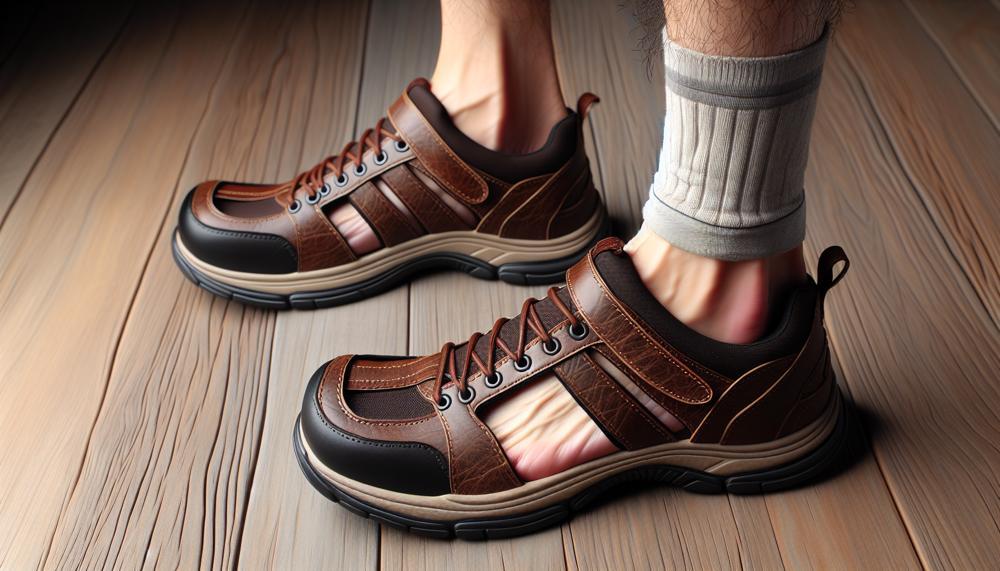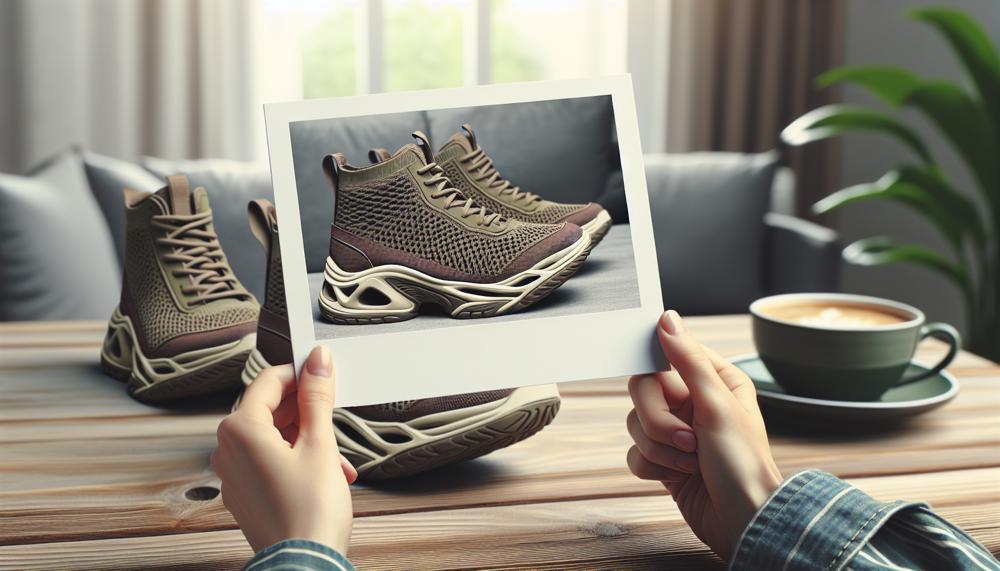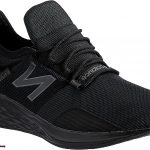Are your wide feet cramped in narrow shoes, giving you blisters and discomfort?
I understand the frustration of finding stylish shoes that actually fit. I know the struggle all too well. Most shoe brands forget about us wide-footed individuals. They leave us with limited options.
In this blog post, we’ll discuss shoes to avoid for wider feet. We’ll also share tips for finding the perfect fit for your unique feet.
Go ahead and kick off those tight shoes. It’s time to discover how to keep your feet happy and fashionable without sacrificing comfort.
What Shoes To Avoid With Wide Feet?
Contents
- 1 What Shoes To Avoid With Wide Feet?
- 2 Understanding Wide Feet and Shoe Sizing
- 3 Pointed Toe Shoes: Why They’re Not Ideal for Wide Feet
- 4 High Arch Support Shoes: A No-No for Those with Wide Feet
- 5 Narrow Width Shoes: The Importance of Proper Fit for Wide Feet
- 6 Slip-On Shoes: Comfort vs. Convenience for Those with Wide Feet
- 7 Tight or Narrow Heels: Potential Issues for Individuals with Wide Feet
- 8 Conclusion

Wide feet can often be frustrating when finding comfortable, well-fitting shoes. Shoe shopping can be daunting due to constant discomfort, pain, and potential foot issues. We are here to shed light on the types of shoes that you should steer clear of to avoid these problems.
Narrow or Pointy Toe Shoes:
Let’s begin with the most obvious culprit – narrow or pointy toe shoes. These footwear choices are notorious for causing discomfort in people with wide feet. They put immense pressure on the toes. They also fail to provide enough room for them to spread out naturally.
This can lead to cramped and uncomfortable feet. It can also cause blisters and deformities, like bunions.
High Heels:
We all adore a pair of elegant high heels, but unfortunately, they are not ideal for people with wide feet.
The elevated heel and lack of support can exert extra strain on the feet, causing pain and discomfort. Moreover, high heels typically have a narrow toe box. This worsens the issue for those with wider feet.
Slip-On Shoes:
Slip-on shoes may seem convenient and effortless to wear. However, they can be problematic for people with wide feet.
These shoes lack laces or straps to adjust the fit. As a result, they are loose and ill-fitting for those with wider feet. This can lead to discomfort and chafing. Ultimately, this can result in blisters and potential foot issues.
Tight-Fitting Shoes:
Shoes that are too tight can cause a range of foot problems, especially for those with wide feet.
Tight shoes can restrict blood flow and compress the toes. This can cause pain and discomfort. Wearing tight-fitting shoes can also cause long-term damage to the feet. This includes nerve damage and deformities.
Flip Flops:
While flip flops may be a popular choice for summer footwear, they are not the best option for people with wide feet.
Understanding Wide Feet and Shoe Sizing
I’ve seen my fair share of customers struggling to find shoes that fit their wide feet . I am a fellow wide-footed individual. I understand the frustration and challenges that come with this unique foot shape.
I’m here to share some tips and tricks on how to find the perfect fit for your wide feet and avoid any discomfort.
Step 1: Know Your Measurements
It may seem like common sense, but many people overlook this crucial step when shopping for shoes. Take a moment to measure the length and width of your feet using a measuring tape or ruler.
This will help you determine the right size for your feet. It will save you from trying on countless pairs of shoes that don’t fit.
Step 2: Look for Specific Width Sizes
Most shoe companies offer a standard range of sizes. It’s important to note that there can be variations within that range. For those with wide feet, it’s crucial to look for shoes that offer specific width sizes, such as 2E or 4E.
These sizes are specially designed to accommodate wider feet and provide a more comfortable fit.
Step 3: Avoid Narrow Toe Boxes
The biggest challenge for those with wide feet is finding shoes with enough room in the toe box. Most shoes are designed with a narrow toe box. This can squeeze and constrict the toes and forefoot. It can cause discomfort and potential foot issues.
To avoid this, look for shoes with a wider toe box or opt for styles like round or square toe instead of pointed ones.
Step 4: Say No to High Heels and Slip-Ons
We all love our stylish high heels and convenient slip-on shoes. However, they may not be the best choice for those with wider feet.
High heels put pressure on the toes and forefoot. This causes discomfort and potential injuries.
Pointed Toe Shoes: Why They’re Not Ideal for Wide Feet
You understand the importance of finding the perfect fit for both style and comfort. But, one crucial aspect that often goes unnoticed in the search for the perfect shoe is the shape of the toe.
Almond, pointed, round, and square toe shapes impact the appearance of the shoe. They also play a significant role in the comfort of your feet. This is particularly vital for those with wide feet or bunions.
Pointed toe shoes may add sophistication to any outfit. Yet, they are not ideal for those with wider feet. Pointed toes are narrow and tapered. This design can cause discomfort and pain for those with broader feet.
The sharp tip of the shoe can put excessive pressure on the toes. This can cause them to overlap, resulting in painful blisters and calluses. Moreover, pointed toes can worsen existing bunions and make them more uncomfortable.
So which toe shapes are best suited for individuals with wide feet or bunions? Round-toe shoes are an excellent choice for everyday wear. They provide ample room for toes to spread out and are easy to walk in. Recently, square-toe shoes have also gained popularity. They are a versatile option for both casual and formal occasions. Their wider shape allows for more space in the toe box, making them a suitable choice for those with wider feet.
For a balance between pointed and round toes, consider opting for almond-toe shoes. The toe shapes are slightly tapered but still offer enough room for toes to move comfortably. They are a popular choice among women with longer middle toes.
High Arch Support Shoes: A No-No for Those with Wide Feet
Many individuals fixate on finding the perfect arch support when it comes to maintaining foot health. But, not all arch supports are equal. In fact, for those with wider feet, high arch support shoes can actually cause more harm than good.
As a leading expert on “High Arch Support Shoes: A No-No for Those with Wide Feet,” I have witnessed firsthand the detrimental effects these shoes can have on foot health.
Misunderstood Orthotics: The Fallacy
In the medical field, traditional orthotics are often touted as a solution for foot pain. It’s believed that they provide adequate foot support. Yet, this misconception stems from a lack of understanding of how arches function.
Traditional orthotics do not support the ends of the arch. This support is crucial for maintaining its strength. Instead, they lift from the middle and can cause muscle atrophy.
The Significance of Zero Drop Shoes
To support the arch, one must wear zero drop shoes. These types of shoes have a flat heel-toe drop. This allows for natural movement and function of foot muscles. The height of one’s arch does not determine foot health; it is all about how the arch moves and functions.
In fact, people who go barefoot often have healthier feet. People compare those who wear modern shoes to this.
Toe Spacers: A Natural Solution
For individuals with wide feet, toe spacers can be a game-changer. Dr. Ray McClanahan developed Correct Toes. They realign and strengthen foot muscles while walking or running.
They are not intended to provide support. Instead, they promote optimal functioning of muscles, tendons, and bones in the foot. Wearing toe spacers can also improve balance within just four weeks.
Narrow Width Shoes: The Importance of Proper Fit for Wide Feet
This experience can turn into a frustrating and painful one. Finding comfortable and supportive shoes is a struggle for those with wide feet. Wearing narrow shoes can harm foot health.
As an expert in this field, I have seen firsthand the potential issues that arise when individuals with wide feet wear narrow shoes.
- Foot pain is the most obvious and common consequence of wearing narrow width shoes. The pressure on the toes and sides of the feet can lead to soreness and discomfort, making it difficult to walk or stand for extended periods. While those narrow Nike shoes may look stylish, your feet are suffering in silence.
- Corns and calluses are not a cosmetic concern when it comes to wearing narrow width shoes. These thickened areas of skin can form on the toes, heels, or sides of the feet due to constant friction and pressure. In addition to being , they can also be incredibly painful.
- The ugly truth about wearing narrow width shoes for individuals with wide feet is the development of bunions and hammertoes. Bunions are bony protrusions that form at the base of the big toe, caused by constant pressure from ill-fitting shoes. They can be excruciatingly painful and may even require surgery to correct. Similarly, tight shoes force toes into an unnatural position, causing discomfort and difficulty walking.
- Ingrown toenails are another potential nightmare that can result from wearing tight shoes. This occurs when the nails grow into the skin instead of outwards, causing pain and discomfort. To avoid these issues, it is essential to find properly fitting shoes that provide enough room for wide feet.
Slip-On Shoes: Comfort vs. Convenience for Those with Wide Feet
For many, slip-on shoes are the epitome of convenience. Yet, for individuals with wide feet, they can be more of a hindrance than a help. The lack of adjustability and support in slip-ons can create discomfort, pain, and even long-term foot problems. I am an expert on “Slip-On Shoes: The Paradox of Comfort and Convenience for Those with Wide Feet.” I am here to offer valuable insights and advice for those seeking comfortable and supportive slip-ons.
First, individuals with wider feet must consider the design and fit of slip-on shoes before purchasing them. Slip-on shoes offer limited room for adjustments. This makes it challenging for people with wider feet to find a comfortable fit. This is unlike lace-up shoes. This can cause discomfort, pain, and even long-term foot problems. These problems include blisters, corns, and calluses. Thus, it is crucial to look for slip-ons that offer adjustable features. They should have elastic panels or straps to accommodate wider feet.
In addition to adjustability, support is also a crucial factor to consider when selecting slip-on shoes for wide feet. Slip-ons often have a flat sole with minimal arch support. This can be problematic for individuals with wider feet. They may have flatter or broader arches. This lack of support can lead to foot fatigue, arch pain, and even plantar fasciitis. To prevent these issues, seek out slip-ons with excellent arch support and cushioning.
Another essential consideration for those with wide feet is the material used in slip-on shoes. Stiff materials like leather or canvas do not stretch or mold to the shape of the foot. This can cause discomfort and constriction. Instead, choose more flexible, breathable materials like mesh or stretchable fabrics. These can adapt to wider feet. This will prevent discomfort and allow for a more comfortable fit.
Tight or Narrow Heels: Potential Issues for Individuals with Wide Feet
Many people love slip-on shoes for their effortless use and convenience. But, for those with wider feet, these perfect shoes can cause discomfort and distress.
I’m an expert on tight or narrow heels and their issues for people with wider feet. I have valuable advice for Nike enthusiasts on finding the perfect fit.
The Perils of Tight or Narrow Heels for Wide Feet
First, let’s understand why tight or narrow heels can be problematic. Then, we’ll discuss the types of shoes to avoid. Heels embrace the back of the foot to provide stability and support.
Yet, for those with wide feet, this snug embrace can cause discomfort and agony.
The tightness of the heel can lead to pressure and friction on the sides of the feet. This can result in painful blisters or calluses. Furthermore, it can also impact the alignment of the foot. This causes toes to squeeze together and strains the muscles and tendons. This could result in conditions such as hammertoes or bunions. These conditions can be excruciating and need medical attention.
Steering Clear of Tight or Narrow Heels: What Types of Shoes to Avoid
To prevent these issues, individuals with wider feet should steer clear of certain shoe types that have tight or narrow heels. These include pointed-toe shoes, stilettos, and pumps with high heels. These styles come with narrow toe boxes and high heels that can put pressure on the sides of the feet.
Furthermore, individuals should also avoid shoes with straps or laces that wrap around the heel. They can make it challenging for wider feet to fit . This includes popular Nike styles like Air Jordan 1 and Air Force 1.
Conclusion
In conclusion, finding the perfect shoes for wide feet may seem daunting. But it is not impossible. As we have discussed in this blog post, there are certain shoe styles that individuals with wider feet should avoid. This will help them prevent discomfort and potential foot issues.
These include narrow or pointy toe shoes, high heels, slip-ons, tight-fitting shoes, flip flops, and shoes with high arch support.
But do not lose hope – there are numerous options available for those with wide feet. Know your measurements. Seek out specific width sizes. This way, you can find shoes that offer enough space for your unique feet.
Avoid narrow toe boxes. Opt for round or square toe shapes to boost comfort. And let’s not forget about proper support. Consider looking for zero drop shoes and using toe spacers to promote healthy foot function.
Always remember, because a shoe may be trendy or convenient does not mean it is the best fit for your wide feet.






